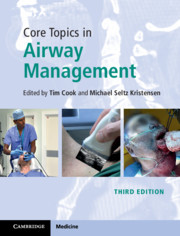Book contents
- Core Topics in Airway Management
- Core Topics in Airway Management
- Copyright page
- Contents
- Contributors
- Foreword
- Preface to the Third Edition
- Section 1 Airway Management: Background and Techniques
- Section 2 Airway Management: Clinical Settings and Subspecialties
- Section 3 Airway Management: Organisation
- Chapter 34 Departmental and Hospital Organisation
- Chapter 35 Training in Airway Management
- Chapter 36 Human Factors in Airway Management
- Chapter 37 Decontamination of Airway Equipment
- Chapter 38 Airway Management in a Respiratory Epidemic or Pandemic
- Index
- References
Chapter 35 - Training in Airway Management
from Section 3 - Airway Management: Organisation
Published online by Cambridge University Press: 03 October 2020
- Core Topics in Airway Management
- Core Topics in Airway Management
- Copyright page
- Contents
- Contributors
- Foreword
- Preface to the Third Edition
- Section 1 Airway Management: Background and Techniques
- Section 2 Airway Management: Clinical Settings and Subspecialties
- Section 3 Airway Management: Organisation
- Chapter 34 Departmental and Hospital Organisation
- Chapter 35 Training in Airway Management
- Chapter 36 Human Factors in Airway Management
- Chapter 37 Decontamination of Airway Equipment
- Chapter 38 Airway Management in a Respiratory Epidemic or Pandemic
- Index
- References
Summary
Performing a stressful task under pressure is challenging. Strategies to optimise our training must focus on learning a skill correctly, and then practising that skill deliberately to avoid compromising that performance in the cauldron of the clinical environment. This chapter discusses ways of learning and training better: the techniques are based on practical strategies employed in anaesthesia, but developed primarily from practical cognitive psychology, elite sport and the military. It involves taking a skill, practising it until it becomes a habit and over time making it part of normal behaviour. The philosophy is simple (but difficult to apply): control what you can control and always do your best. The best summary of this strategy is: learn it right, practise it right, perform it right.
Information
- Type
- Chapter
- Information
- Core Topics in Airway Management , pp. 299 - 304Publisher: Cambridge University PressPrint publication year: 2020
